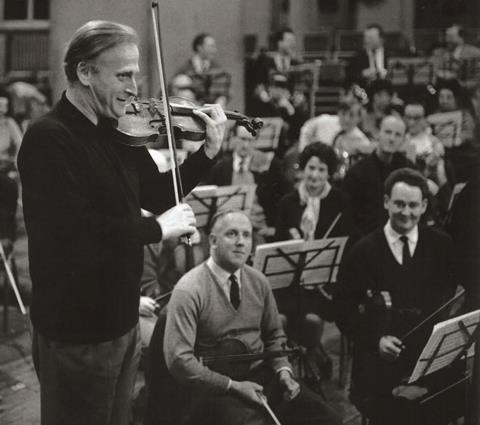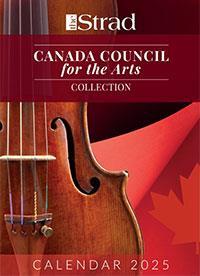Julian Haylock examines the player whose openness and sincerity gave even lighter music a profound emotional resonance

Discover more Featured Stories like this in The Strad Playing Hub
This article appeared in the November 2009 issue of The Strad
The most musically gifted violin prodigy of his generation, Yehudi Menuhin was one of the defining figures in 20th-century culture. From jamming with Stéphane Grappelli to conducting the Berlin Philharmonic with his feet, he devoted his life to breaking down musical barriers.
Chronology
1916 Born in New York
1924 Public debut with Bériot’s Scène de ballet
1929 Makes first solo recordings for HMV
1932 Records Elgar Concerto with the composer conducting 1939 Plays over 500 concerts for the Allies during World War II 1951 Discovers yoga
1959 Masterminds the Bath Festival
1963 Establishes Yehudi Menuhin School
1985 Becomes a British citizen
1999 Dies in Berlin, aged 82
PEDAGOGICAL BACKGROUND
Menuhin’s first teacher was Sigmund Anker, an authoritarian figure who between 1921 and 1923 kept his young charge on a tight rein. Louis Persinger then took over and saw Menuhin through the remainder of his early prodigyhood. ‘When I began it was pure instinct,’ Menuhin later recalled. ‘I had the knack, the gift, the will.’ So important was Persinger to Menuhin that when the teacher moved from San Francisco to New York in 1925, the whole Menuhin family followed him.
‘He demonstrated and I imitated,’ was how Menuhin neatly encapsulated his lessons with Persinger. The following year the family travelled to Europe, but when Ysaÿe (Persinger’s teacher) offered to provide him with some firm technical discipline, Menuhin turned him down. ‘Music was something very alive to me,’ he later reflected, ‘an essential means of expression, and I suspect that unending hours of work on dull material might well have blunted rather than polished my interpretation of it.’
Hindsight is a wonderful thing, but the technical frailties Menuhin suffered from in later life might well have been avoided had he taken Ysaÿe’s advice. However, in 1927 Menuhin began lessons with his hero George Enescu, with whom he struck up an instant rapport despite an age gap of 35 years: ‘What I received from Enescu was the note transformed into vital message, the phrase given shape and meaning, the structure of music made vivid.’ In 1929 and 1930 Menuhin also had a series of consultations with Adolph Busch. ‘Without him,’ he fondly remembered, ‘I would not have been able to understand and penetrate the spirit and heart of that music of mists and forests, of drama and contained passion.’
TECHNIQUE AND INTERPRETATIVE STYLE
Menuhin captured the emotion of the moment like no other violinist. His unvarnished emotional openness and sincerity spoke directly from the heart to the heart. In Menuhin’s hands the violin became a natural extension of his being, it gave voice to his most intimate feelings and revealed his inner soul with poignant eloquence. At the peak of his form he gave transcendent performances that produced the strange impression of the music flowing through him, as though there were no mechanics involved at all.
That said, the pyrotechnics of violin playing were to become a sword in Menuhin’s side for much of his later career. By his own admission, up until 1936, when he was already 20 years of age, he had survived on sheer musical instinct and natural ability. His technique had evolved naturally out of a compelling desire to make music at an astonishing level of maturity for one so young. It was the realisation that he could not continue indefinitely surviving on inspiration and adrenaline alone that he now began, in effect, relearning the instrument in an attempt to rationalise what had so far come completely naturally.
So natural was Menuhin’s prodigious talent that he sounded completely at home in virtually any style
The pull between Menuhin the supremely natural musician and Menuhin the executant violinist lies at the heart of the problems that would occasionally beset him in later life. By the 1970s his concert appearances ranged from blazing triumphs of musical incandescence to spiritually uplifting performances compromised by technical discomfort. Judged by the very highest standards, Menuhin’s technique was not ostentatiously brilliant: his intonation could be less than ringingly pure, his bow strokes were not strikingly mellifluous, the coordination between his left and right hands rarely blemishless. Yet none of this seemed to matter given Menuhin’s profound artistry and mesmerising stage presence.
SOUND
To experience the Menuhin sound at its most natural, his pre-war recordings are essential listening. Here the sound is uniquely direct in its plangent chasteness, and it’s as though one is listening to a human voice, with no sensation of sophisticated technical airs and graces.
STRENGTHS
So natural was Menuhin’s prodigious talent that he sounded completely at home in virtually any style. He never used music for mere display but always sought to reveal the inner soul of even the lightest of musical pleasantries.
WEAKNESSES
Menuhin’s inspirational art was dependent above all on capturing the moment as if spellbound by its divine majesty. In later years, this left him vulnerable to technical fallibilities, especially in the lower half of the bow.
INSTRUMENTS AND BOWS
Menuhin amassed a large number of instruments and bows during his career, many of which (over a hundred) were auctioned at a famous Sotheby’s sale in November 1999. His collection ranged from a small Stefano Scarampella to an 1862 Jean Baptiste Vuillaume to fine examples by Lorenzo and Tomaso Carcassi. The instruments with which he was most closely associated included the 1733 ‘Prince Khevenhüller’ Stradivari, which he was presented with when he was twelve years old, the 1714 ‘Soil’, now owned by Itzhak Perlman, and no fewer than six violins by Guarneri ‘del Gesù’, most notably the 1739 ‘Menuhin’ and two magnificent 1742 instruments, the ‘Menuhin’ and the ‘Lord Wilton’. His father bought him three Sartory bows, and he also owned distinguished examples by Tourte (c.1810), Peccatte and Kittel.
REPERTOIRE
At the core of Menuhin’s repertoire lay the Austro-German classics. On peak form he imbued the concertos of Bach, Beethoven, Mendelssohn, Schumann, Bruch, Brahms and Berg with a noble intensity and sense of spiritual grandeur that for a whole generation of listeners and concert-goers virtually defined what this music was all about. Yet it was the way he found profound emotional resonances in music of less exalted quality that was perhaps his greatest gift.
No violinist has performed Paganini’s D major Concerto with such heartfelt dignity and expressive ardour, nor the concertos of Bloch, Sibelius, Delius and (most especially) Nielsen. He was a master of centralist 20th-century music – his Bartók is so deeply insightful that one can’t imagine why he didn’t record the two Prokofiev concertos or the Glazunov. Menuhin was also a deeply committed chamber music player, both in accompanied music (as witness his many fine recordings with his sister, Hephzibah) and in ensemble. One particularly happy outcome of his many distinguished orchestral recordings is his glorious playing of the Bourrée classique violin solo from Britten’s Variations on a Theme of Frank Bridge.
RECOMMENDED RECORDINGS
Bach: Double Violin Concerto EMI CLASSICS 7 67310 2
Beethoven: Violin Concerto EMI CLASSICS 5 66975 2
Elgar: Violin Concerto EMI CLASSICS 5 66979 2
Mozart: Violin Concerto no.3 EMI CLASSICS 7 63718 2
Nielsen: Violin Concerto EMI CLASSICS 2 64198 2
Walton: Violin Concerto, Viola Concerto EMI CLASSICS 9 68944 2
Read: Yehudi Menuhin’s marked-up copy of Bach’s Solo Violin Sonata no.2
Read: From the archive: Yehudi Menuhin discusses his violins, including this Guarneri copy by Glen Collins
Read: Bow holds of the great violinists
Read more Featured Stories like this in The Strad Playing Hub
The number one source for playing and teaching books, guides, CDs, calendars and back issues of the magazine.
In The Best of Technique you’ll discover the top playing tips of the world’s leading string players and teachers. It’s packed full of exercises for students, plus examples from the standard repertoire to show you how to integrate the technique into your playing.
The Strad’s Masterclass series brings together the finest string players with some of the greatest string works ever written. Always one of our most popular sections, Masterclass has been an invaluable aid to aspiring soloists, chamber musicians and string teachers since the 1990s.
The Canada Council of the Arts’ Musical Instrument Bank is 40 years old in 2025. This year’s calendar celebrates some its treasures, including four instruments by Antonio Stradivari and priceless works by Montagnana, Gagliano, Pressenda and David Tecchler.













































No comments yet